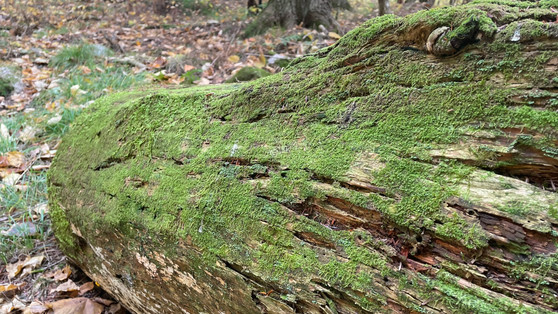Nature Meditations and Moss
- Nicole Rottinghaus

- Oct 15, 2024
- 3 min read
"The River Nile is the longest river on Earth. Spanning over 4,000 miles, it runs through eleven countries, supporting millions of people along its banks. Today, spend at least 10 minutes walking in silence in a outdoor space. Bring your awareness to all the details that make up the place, big and small. Think of the people it supports, the animal and plant lives it sustains." - Todays nature meditation from Kenya Jackson-Saulters
Today's nature mediation took me down a rabbit hole.... surprise! Today's rabbit hole is moss. But, before we get to that, take a look at some of the amazing colors from this morning's 2-mile hike.
Today's hike brought on a number of observations. First. Humans are the worst.
Second, moss is pretty cool!
This prompted me to learn a bit more about moss... learn along with me!
The Royal Botanic Gardens is where I started.
What is Moss?
Mosses are non-flowering plants that produce spores and have stems and leaves, but do not have true roots. They are classified as Bryophyta in the plant kingdom. This species dates back over 450 million years and is comprised of approximately 25,000 species.
They don't have roots, instead they have rhizoids, which are small hairlike structures that anchor them to a rock, bark, or soil. Some moss suck nutrients up through the rhizoids and others draw in moisture and minerals from rain and water through their highly absorbent surfaces.
They are tougher than they look and can occupy areas that are otherwise uninhabitable. Different species can adapt to survive in the most extreme conditions from 5F to 104F. When they are dried out, they can survive heat much better. When dry, they can survive temps as high as 212F to as low as -458F. There is a good definition of resilience and adapting to ones environment.
Mosses function like sponges. They help to soak up rainfall, maintain moisture in the soil below and keep conditions around them humid. This allows other plants around them to thrive. Mosses also play a vital role in the development of new ecosystems. They're among the first plant colonizers of disturbed sites, such as when an area is deforested or affected by forest fires. They stabilize the soil surface and retain water, helping new plants to grow.
Temperature control - in hot places, they protect roots by shading and insultating the soil from high temperatures. In the Arctic, they can prevent the warmth of the sun from reaching the ground and reduce the speed at which ice thaws, keeping it cooler for longer.
Some mosses are luminous - meaning they have adapted to low light conditions and shine an emerald green color. Protonema are thread-like structures that grow from a moss spore. Inside the protonema, the chloroplasts gather together to receive the maximum amount of available light and the lens-shaped cells help to focus the light. The reflection of light from these chloroplasts is what causes the green luminous glow.
From miniature plants to gigantic trees, biodiversity is the incredible variety of all life on earth. Mosses are important components of the vegetation in many regions of the world, and they make up a major part of the biodiversity in moist forest, wetland, mountain and tundra ecosystems. Moss communities offer microhabitats that are critical to the survival of a diversity of organisms. They provide valuable shelter for insects to live, lay their eggs and hunt for food. Even creatures like turtles can benefit from the ability of the mosses to buffer temperatures. In Ontario, Canada, spotted turtles spend the winter sheltering under Sphagnum moss which protects the turtles from getting too cold in conditions that can drop to -31F.
My current favorite type of moss is American Tree Moss. It is a Pleurocarpous moss and it resembles a tiny forest of trees.



























Comments